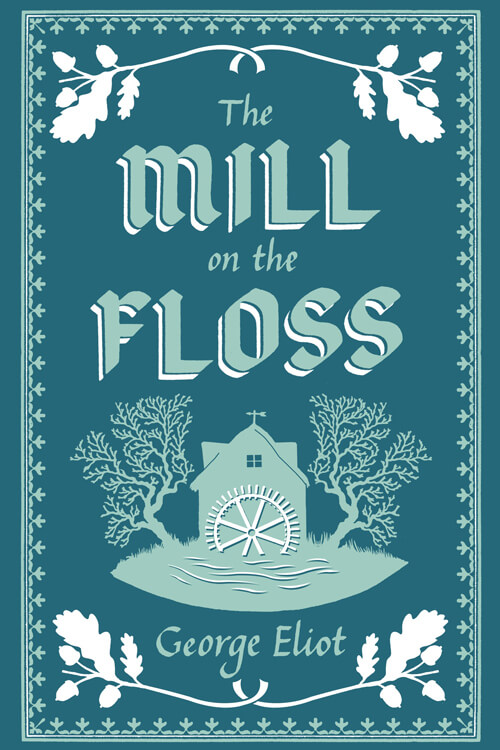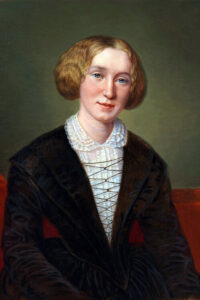
The Mill on the Floss
A wide plain, where the broadening Floss hurries on between its green banks to the sea, and the loving tide, rushing to meet it, checks its passage with an impetuous embrace. On this mighty tide the black ships—laden with the fresh-scented fir-planks, with rounded sacks of oil-bearing seed, or with the dark glitter of coal—are borne along to the town of St. Ogg’s, which shows its aged, fluted red roofs and the broad gables of its wharves between the low wooded hill and the river-brink, tingeing the water with a soft purple hue under the transient glance of this February sun. Far away on each hand stretch the rich pastures, and the patches of dark earth made ready for the seed of broad-leaved green crops, or touched already with the tint of the tender-bladed autumn-sown corn. There is a remnant still of last year’s golden clusters of beehive ricks rising at intervals beyond the hedgerows, and everywhere the hedgerows are studded with trees; the distant ships seem to be lifting their masts and stretching their red-brown sails close among the branches of the spreading ash. Just by the red-roofed town, the tributary Ripple flows with a lively current into the Floss. How lovely the little river is, with its dark changing wavelets! It seems to me like a living companion while I wander along the bank and listen to its low, placid voice, as to the voice of one who is deaf and loving. I remember those large dipping willows. I remember the stone bridge.
And this is Dorlcote Mill. I must stand a minute or two here on the bridge and look at it, though the clouds are threatening, and it is far on in the afternoon. Even in this leafless time of departing February, it is pleasant to look at,—perhaps the chill, damp season adds a charm to the trimly kept, comfortable dwelling-house, as old as the elms and chestnuts that shelter it from the northern blast. The stream is brimful now and lies high in this little withy plantation, and half drowns the grassy fringe of the croft in front of the house. As I look at the full stream, the vivid grass, the delicate bright-green powder softening the outline of the great trunks and branches that gleam from under the bare purple boughs, I am in love with moistness and envy the white ducks that are dipping their heads far into the water here among the withes, unmindful of the awkward appearance they make in the drier world above.
Read or download Book
George Eliot
Mary Ann Evans (22 November 1819 – 22 December 1880), known by her pen name George Eliot, was an English novelist, poet, journalist, translator, and one of the leading writers of the Victorian era. She wrote seven novels: Adam Bede (1859), The Mill on the Floss (1860), Silas Marner (1861), Romola (1862–1863), Felix Holt, the Radical (1866), Middlemarch (1871–1872) and Daniel Deronda (1876). Like Charles Dickens and Thomas Hardy, she emerged from provincial England; most of her works are set there. Her works are known for their realism, psychological insight, sense of place, and detailed depiction of the countryside.
Middlemarch was described by the novelist Virginia Woolf as “one of the few English novels written for grown-up people” and by Martin Amis and Julian Barnes as the greatest novel in the English language.
Life
Mary Ann Evans was born in Nuneaton, Warwickshire, England, at South Farm on the Arbury Hall estate. She was the third child of Welshman Robert Evans (1773–1849), manager of the Arbury Hall estate, and Christiana Evans (née Pearson, 1788–1836), daughter of a local mill owner. Her full siblings were: Christiana, known as Chrissey (1814–59), Isaac (1816–1890), and twin brothers who died a few days after birth in March 1821. She also had a half-brother, Robert Evans (1802–64), and half-sister, Frances “Fanny” Evans Houghton (1805–82), from her father’s previous marriage to Harriet Poynton (1780–1809). In early 1820, the family moved to a house named Griff House, between Nuneaton and Bedworth.
The young Evans was a voracious reader and intelligent. Because she was not considered physically beautiful, Evans was not thought to have much chance of marriage, and this, coupled with her intelligence, led her father to invest in an education not often afforded to women. From ages five to nine, she boarded with her sister Chrissey at Miss Latham’s school in Attleborough, from ages nine to thirteen at Mrs. Wallington’s school in Nuneaton, and from ages thirteen to sixteen at Miss Franklin’s school in Coventry. At Mrs. Wallington’s school, she was taught by the evangelical Maria Lewis—to whom her earliest surviving letters are addressed. In the religious atmosphere of Misse Franklin’s school, Evans was exposed to a quiet, disciplined belief opposed to evangelicalism.
After age sixteen, Evans had little formal education. Thanks to her father’s important role on the estate, she was allowed access to the library of Arbury Hall, which greatly aided her self-education and breadth of learning. Her classical education left its mark; Christopher Stray has observed that “George Eliot’s novels draw heavily on Greek literature (only one of her books can be printed correctly without the use of a Greek typeface), and her themes are often influenced by Greek tragedy”. Her frequent visits to the estate also allowed her to contrast the wealth in which the local landowner lived with the lives of the often much poorer people on the estate, and different lives lived in parallel would reappear in many of her works. The other important early influence in her life was religion. She was brought up within a low-church Anglican family, but at that time the Midlands was an area with a growing number of religious dissenters.






